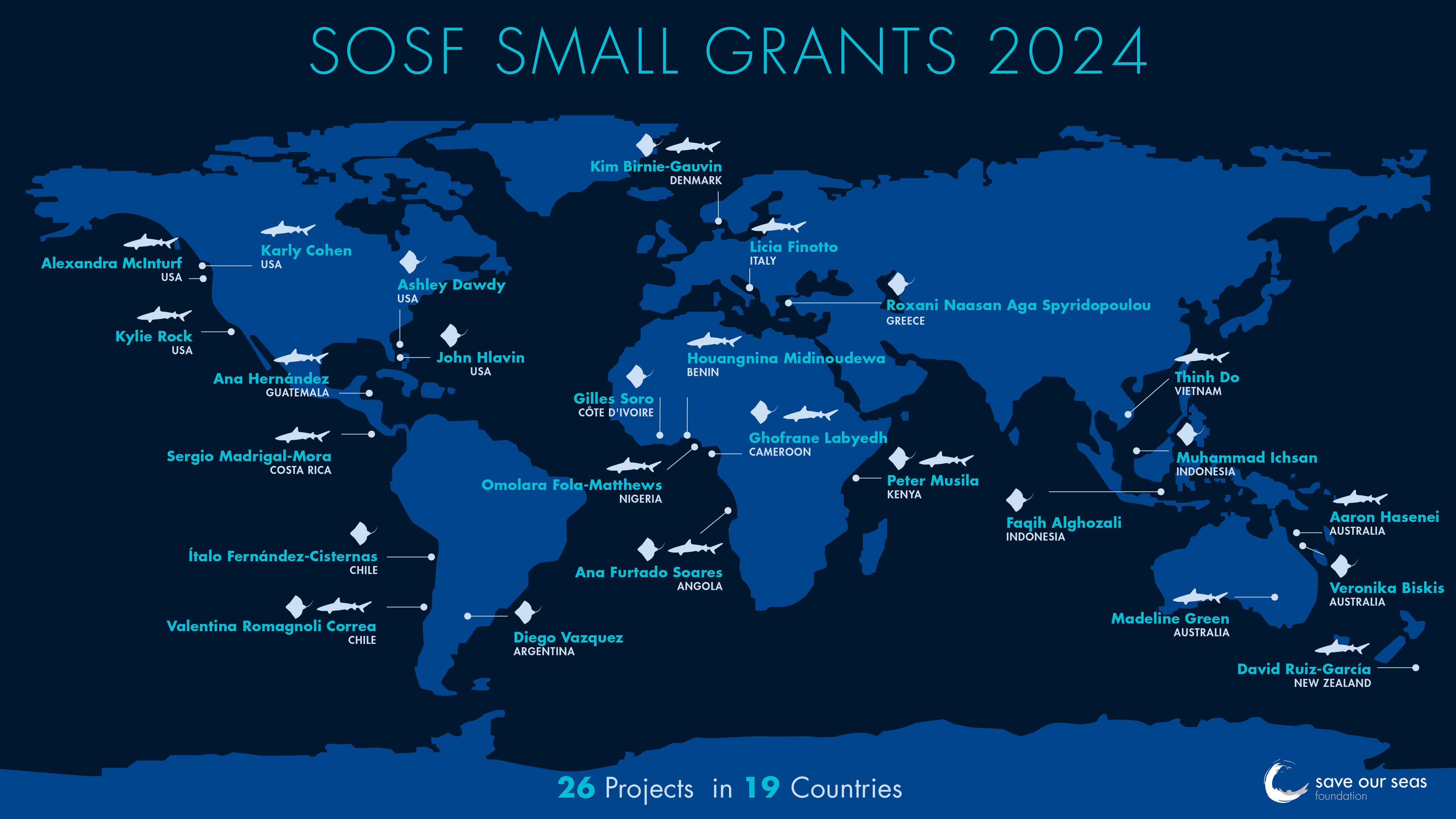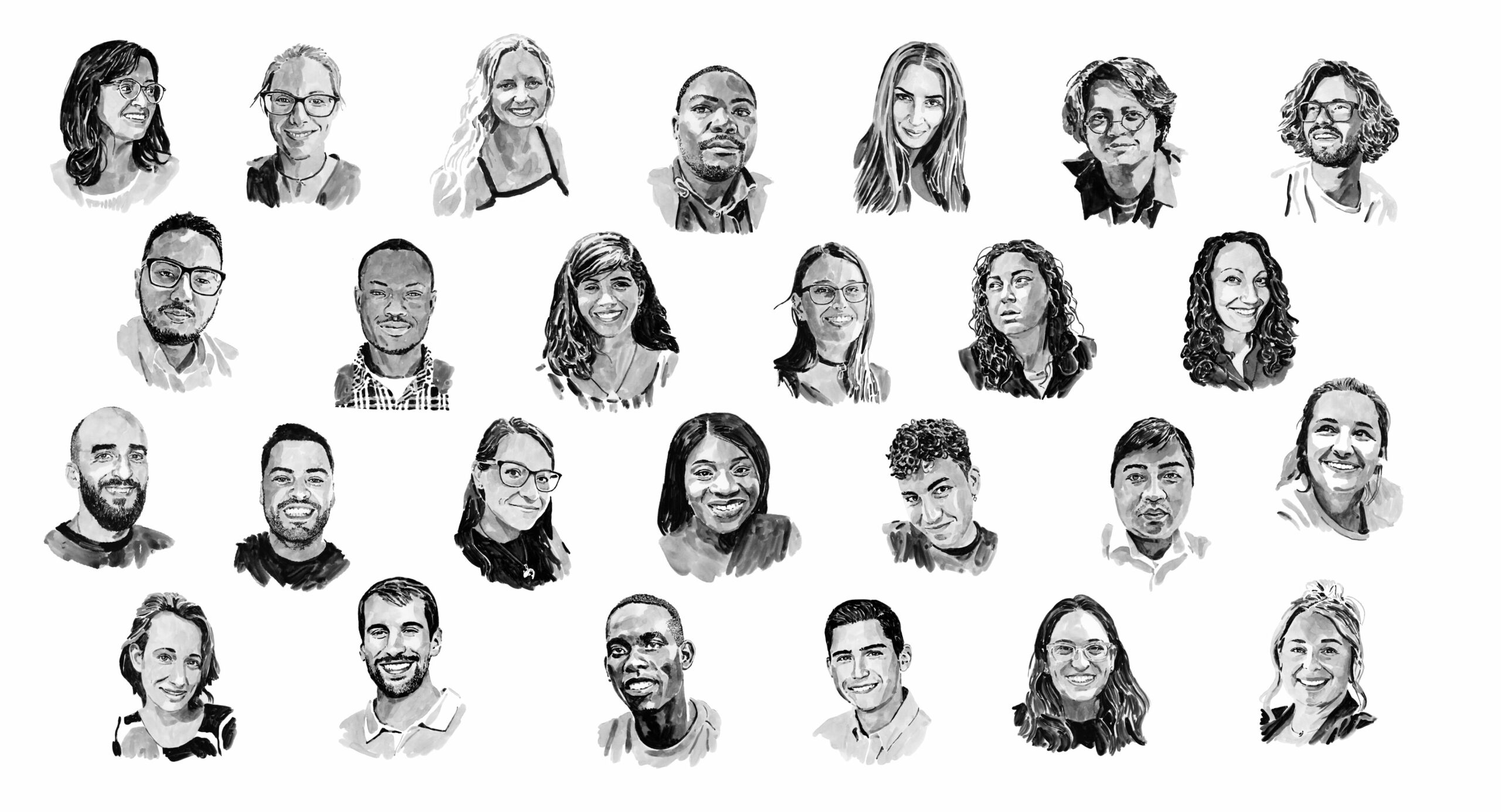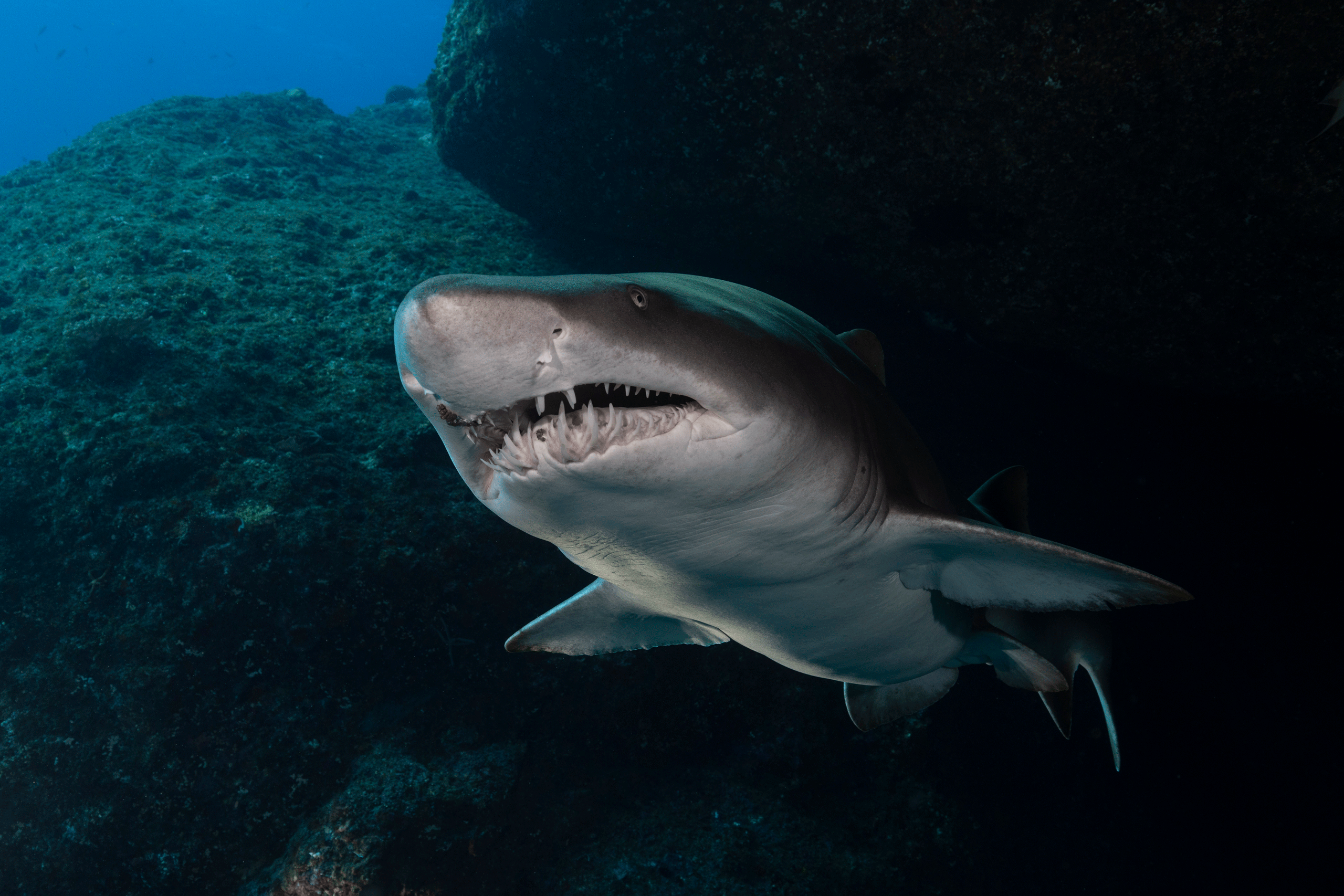Meet our 2024 Small grant project leaders
Endangered, far-flung, and young; that’s the Save Our Seas Foundation’s 2024 cohort of projects, their focus species, their ecosystems – and their leaders. The leaders span those working to conserve endangered and overlooked species, early career scientists blazing trails for a new generation of hope, and conservationists balancing the challenges of working in under-resourced and under-represented regions.
Angola is recovering from decades of civil war, but its sharks and rays remain in deep trouble. With intense pressure from coastal and offshore fisheries, their populations have been in decline since the demand for fins emerged in the 1970s. Ana Lúcia Furtado Soares understands that society and the environment are linked; conservation simply can’t be left behind because, no matter how great the many other challenges, our future well-being is linked to the health of our environment. She is gathering a plethora of information from biological samples to fisheries catch data, understanding national and international trade and reducing threats to sharks and rays – all with the goal of securing the future for sharks, rays and the communities that rely on them. Aaron Hasenei is also looking to the future; he is testing how epaulette sharks respond to different temperatures that model future climate scenarios. It’s information he believes is critical to understanding what the success of sharks and rays will be in the future.

Artwork by Jamy Silver | © Save Our Seas Foundation
The project leaders announced for 2024 comprise a complement of conservationists, scientists and educators whose work is an investment in the world we want to create. With climate change, overfishing, pollution and habitat destruction looming large, it is a hopeful thing to look at the collection of faces sketched here and know that such dedication and innovation are forging the future. This year, there are projects casting light on species that have been overshadowed and under-researched. Karly Cohen is diving deep into our oceans and into evolutionary history to explore how Pacific ratfish, a type of chimaera (ancient kin of sharks), reproduce and grow. John Hlavin is figuring out where the Atlantic guitarfish fits in the food web, and Kim Birnie-Gauvin is tracking thornback rays in Denmark – all are species about which virtually nothing is known. There are others who prioritise species of critical conservation concern; Roxani Naasan, for instance, is scouring the Thracian Sea for the nursery sites and breeding grounds of the endemic rough skate.
And then some projects combine both under-researched species and overlooked areas: Diego Martin Vaquez is tagging the planet’s only freshwater chondrichthyan, giant freshwater stingray, in the middle and lower Paraná River to understand its movement patterns and guide where conservation efforts should focus. Many projects have emerged in regions where funding and focus have previously seldom found traction. Gilles Florent Soro is gathering a baseline for the guitarfish of Grand-Béréby, Côte d’Ivoire’s first marine protected area. Emmanuel Midinoudewa is compiling a Red List of threatened sharks in Benin’s waters, while Ghofrane Labyedh is documenting Cameroon’s small-scale fisheries and their shark catches. From Kenya to Chile, Angola to Australia, Vietnam to New Zealand and Indonesia to Argentina, this year’s projects span 18 different countries.

Portrait artwork by Samuel Kerr | © Save Our Seas Foundation
Continuity, long-term monitoring, and collaboration remain at the core of what conservation requires for success. With this in mind, the Foundation continues to fund the SOSF D’Arros Research Centre in Seychelles, the SOSF Shark Education Centre in South Africa and the SOSF Shark Research Centre in the United States of America. Its long-standing partners – the Bimini Biological Field Station Foundation, Manta Trust, North Coast Cetacean Society, Shark Spotters and The Acoustic Tracking Array Platform – all received renewed funding to continue their vital work in ocean conservation. In addition, the SOSF is funding 30 continuation grants in 2024. Continuation grants are awarded to project leaders who have received keystone funding, and have shown significant progress towards achieving a larger, longer-term project goal. Excitingly, this brings to 56 the total number of grants awarded by the SOSF in 2024.
Whether it’s diving into the wonders of Watamu Marine National Park in Kenya with project leader Peter Musila, or sleuthing shark fin IDs using DNA in Vietnam with Thinh Dinh Do, you can follow project news and learn more about our oceans by visiting the Project Leader story section here and following the Save Our Seas Foundation on social media. Delve into the complexities of the scalloped hammerhead trade in Nigeria with Lara Fola-Matthews, follow the development of a tool to trace shark liver oil products with Madeleine Green, sail to the wedgefish hotspot of Sungai Kakap with Muhammad Ichsan, and immerse yourself in the submarine forests off Chile’s coast with Italo Fernandez. We think that, aside from all you’ll learn, these will be stories that bring you hope and inspiration. If these are the people our blue future is entrusted to, we’d all do well to follow along and be their rising tide of support.

Photo © Simon Hilbourne
2024 Small grant project leaders:
- Emmanuel is compiling a Red List of threatened sharks in Benin’s waters, and sparking new inspiration for a community-driven conservation initiative in the country.
- Aaron is testing how epaulette sharks respond to different temperatures that model future climate scenarios. He wants to understand the genetics that underpin how epaulette sharks might respond.
- Sharks and rays face a host of threats, but the single greatest one is fishing pressure. Even with management interventions and mitigation measures, many sharks and rays are still vulnerable to unintentional capture. David’s on a mission to understand and assess how sharks fare once captured, and what happens to their health even when they’re released.
- Ghofrane knows that Cameroon’s small-scale fisheries present a conservation conundrum: they account for many threatened sharks and rays in their daily haul, but there is no effective, enforced management plan for them. His intention is to improve conservation for the most landed and the most threatened species caught on Cameroon’s southern coast.
- As one of East Africa’s oldest marine protected areas (MPAs), Watamu Marine National Park shelters many species and habitats. However, with increasing pressure on the park from neighbouring communities, Peter is working to strengthen partnerships, empower local communities and foster a sense of ownership and responsibility for the sustainable management of these vital marine species.
- Chile’s artisanal catch report form is in need of overhaul. Valentina is describing and quantifying the underestimation of artisanal shark catches. She also wants to propose constructive changes to the local authorities.
- The barriers to the successful recovery of smalltooth sawfish are formidable, and some say it would take a century. But Ashley is hopeful that more can be done to ensure that we hasten these Critically Endangered rays towards recovery.
- Ana is helping to grow the body of knowledge that exists for the Guatemalan Caribbean’s sharks and rays. Using different survey methods, from monitoring landing sites to involving fishers and community members, her focus species have expanded with the incursion of fishing into deeper waters to include new records for the region.
- Vietnam presents two sides of a shark conservation coin: it has high species diversity and a long history of shark fishing. Thinh Dinh Do worries about the ability to accurately detail which species of sharks are being caught in the region because sharks are most often finned at sea and landed with only fins available from which to identify species.
- As the world’s only exclusively freshwater chondricthyan, the giant freshwater stingray is remarkable – and increasingly rare. With high fishing pressure and no protection measures in place, the need for conservation intervention is critical. Diego is tagging giant freshwater stingrays in the middle and lower Paraná River to determine their seasonal migrations and habitat use and the extent of individual movements in the river system.
- With more than 10,000 tonnes of sharks landed annually, the FAO has highlighted Nigeria as one of the world’s biggest shark-fishing nations. Lara wants to harness the local ecological knowledge of Nigerian fishers to understand how scalloped hammerhead sharks are being caught and traded, and ultimately help foster community-driven education and conservation efforts in the region.
- The position of most sharks as predators in the food web puts them at high risk of impacts by pollution, since longer-lived, larger-bodied animals that eat other animals tend to accumulate more toxins and pollutants throughout their lifetime. Licia is measuring the pollution levels in three shark species in the highly impacted Mediterranean Sea.
- Kylie is comparing pollution levels in the broadnose sevengill (or cowshark) and the tope shark at a highly impacted site and a pristine site in the San Francisco Bay and Willapa Bay estuaries, respectively.
- Populations of the Pacific spiny dogfish are in freefall, but are current surveys assessing the right habitats to make management decisions? Alexandra worries that the absence of movement data from current fisheries surveys means that a part of their story is not being used.
- Faqih is searching for giants and rarities: the giant guitarfish and wedgefish of Karimunjawa National Park in the Javan Sea off the coast of northern Central Java. He aims to develop an effective and inclusive management plan for these vulnerable shark-like rays.
- Karly is diving into the depths of the ocean – and time – to uncover the mysterious lives of Pacific spotted ratfish. Harnessing technology, from ROVs to 360° cameras, she aims to understand how ratfish reproduce and start their lives.
- Endemic and Endangered, the rough skate is a conservation priority in Greece’s Thracian Sea. Although the Thracian Sea Shelf has been identified as an Important Shark and Ray Area (ISRA) by the IUCN, confirmation of nursery grounds or breeding sites still need to be recorded. Roxani is hoping to do just this, while defining reproductive aggregations of this species.
- In the protected waters of the St Elena Bay Marine Management Area on the north Pacific coast of Costa Rica, Pacific nurse sharks move in an ocean that is changing temperature. Sergio believes the colder temperatures must influence where these sharks are moving and aggregating.
- Angola’s elasmobranchs (sharks and rays) are in big trouble. With intense pressure from coastal and offshore fisheries, their populations have been in decline since the demand for fins emerged in the 1970s and the country’s decades-long civil war. Ana‘s goal is to secure the future for sharks and rays, and the communities that rely on them.
- As Ivory Coast’s first marine protected area (MPA), declared in 2022, Grand-Béréby needs ongoing research to inform a management plan that is not yet available. Three guitarfish species were identified in the MPA, and Gilles has set out to confirm these observations and establish their identifications, as well as search for other potential guitarfish in the region.
- The ecological role as a ‘home’ to scores of marine species is lacking for our submarine forests, is an issue that Italo is tackling for Chile’s Humboldt kelp forests. With unregulated exploitation threatening kelp forests, Italo is focusing on the role of huiro palo kelp as sites for egg-laying sharks and rays.
- Veronika is innovating microchemical analysis on the teeth from confiscated sawfish rostra to trace the animals’ movement patterns throughout their life. As a lifeboat for remaining sawfish, Australia is a key player in their conservation.
- Sungai Kakap is a hotspot for rays in Indonesia and, in particular, the highly threatened wedgefish species. Muhammad is on a mission to populate baseline fisheries information for wedgefish at Sungai Kakap in West Kalimantan, determining their diet, elements of their life history and their population structure.
- The ‘Forgotten of the North’ project is redressing the critical dearth of knowledge about thornback rays in Danish waters. Kim is using acoustic tagging to monitor their movement patterns and identify migration routes, aggregation sites and the highest-use areas that would need protection.
- Madeline is trading tips, and drawing on insights from research into olive oil traceability to develop methods for determining which species are being used in shark liver oil products (squalene). The threatened gulper shark is the most common source, but Madeline wants to develop a protocol for extracting DNA from liver oil products to identify which shark species have been used for them.
- Almost nothing is known about the Atlantic guitarfish; there is very little in the literature about this species, which belongs to a most vulnerable group of shark-like rays. John believes a lack of compassionate PR for this ‘less charismatic’ kin of the sawfish is to blame for the relatively little attention paid to efforts to conserve it and aims to figure out where it fits in the food web.
